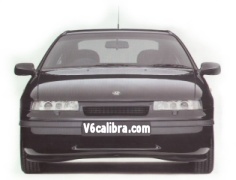 |
V6 Calibra |
|
Key Facts:
The Auxiliary belt uses a single spring tensioner wheel which is mounted above the alternator. The auxiliary belt tensioner assembly should be changed every 100,000 miles - or earlier if the wheel bearing becomes 'noisy'. It is important to realise that the auxiliary belt is responsible for driving the primary mechanical water pump. If it should snap or shred whilst driving you are advised to stop as soon as you can. No water pump means no coolant is being circulated through the engine block pathways. This is bad for the V6 engine and can very rapidly lead to blown head gaskets if the engine continues to run with no operating water pump. The V6 does have a secondary electrical water pump but this only runs when the engine is hot and the ignition is switched off. |
Auxiliary Belt Change
You will need a trolley jack, axel stands and a good socket (15mm) with breaker bar extension (to undo the bottom engine mount). Remove the following to allow easy access for the job:
- Air intake filter box and pipe work back to the throttle body (needed for access)
- Front drivers side wheel and wheel arch liner (needed for access)
- Front bumper (optional - can help when accessing lower engine mount)
Cam Belt Change
under development
V6 Cam Belt Revision - 1997
Some of the last V6 Calibra's featured an improved cam belt system. Improvements were made to reduce belt noise and prolong toothed belt life. A new toothed belt material was also introduced at this time:
- Improved front cam belt cover in region of water pump to reduce noise.
- New cam belt tension roller with additional flanged front wheel
- Modified tension roller base plate (new ones identified by code letter "E", old type had "D" code letter)
These modifications enabled Vauxhall to increase the recommended belt change interval to every 80,000 miles or 8 years (from the original 40,000 or 4 years). However, this was later lowered back to 40,000 miles / 4 years after instances of premature belt failure.
V6 Calibra '93 - Feb '97 Part No Cat No Toothed Cam Belt (change interval : 40,000 miles) 90 500 360 06 36 579 Toothed Cam Belt Tensioner Rollers + Base Plate (Type D) 90 528 222 56 36 417 V6 Calibra Feb '97 - '98 Part No Cat No Toothed Cam Belt (change interval : 80,000 miles) 90 530 399 56 36 354 Toothed Cam Belt Tensioner Rollers + Base Plate (Type E) 90 570 844 56 36 420 The new tensioner wheel has a flange to help retain the cam belt. This requires a change in the procedure used when installing a new belt as the belt must now be fed clockwise through the tensioner wheel as opposed to just being able to push it over the tensioner wheel as before.
Once the new toothed cam belt has been fed clockwise through the first roller tensioner (labelled 1 in the diagram below) you should follow the installation order (2,3 ... etc) as detailed here: